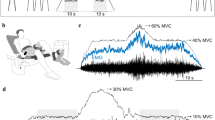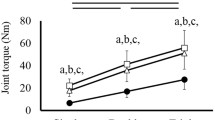Abstract
The endurance time provides a convenient means to assess muscle fatigue resistance. The purpose of the experiments was to study endurance time characteristics of human ankle dorsiflexion and plantarflexion as a function of level of contraction. Nine subjects (four men, five women) were examined. The experimental protocol consisted of determining each individual maximum voluntary contraction (MVC) before each fatiguing experiment and undertaking only one fatiguing isometric contraction (dorsiflexion or plantarflexion) per day. Each subject produced at least six plantarflexion and six dorsiflexion contractions chosen from 15% to 90% MVC. An exponential model was fit to data for each individual and was then fit to the pooled data. The variance accounted for was over 99% for both dorsiflexion and plantarflexion mean values. As expected, endurance time declined as the contraction level increased. Plantarflexing responses presented a higher variation from subject to subject than for dorsiflexing. Inter-subject variability primarily seemed to involve a change in the shape of the endurance curve rather than a shift of the curve. When the data were pooled, the exponential curve had parameters similar to the average of the individual fits. Human ankle dorsiflexion and plantarflexion endurance times as a function of level of contraction were found to be similar under the present experimental conditions.
Similar content being viewed by others
References
Arendt-Nielsen L, Mills KR (1988) Muscle fiber conduction velocity, mean-power frequency, mean EMG voltage and force during submaximal fatiguing contractions of human quadriceps. Eur J Appl Physiol 58:20–25
Bélanger AY, McComas AJ, Elder GBC (1983) Physiological properties of two antagonistic human muscle groups. Eur J Appl Physiol 51:381–393
Béliveau L, Van Hoecke J, Garapon-Bar C, Gaillard E, Herry J, Atlan G, Bouissou P (1992) Myoelectrical and metabolic changes in muscle fatigue. Int J Sports Med 13:S153-S155
Bigland-Ritchie B (1981) EMG/force relations and fatigue of human voluntary contractions. In: Miller D (ed) Exercise and sports sciences reviews (American College Sports Medicine Series, vol. 9) J. Wiley, New York, pp 75–117
Bigland-Ritchie B (1984) Muscle fatigue and the influence of changing neural drive. Clin Chest Med 5:21–34
Bigland-Ritchie B, Woods JJ (1984) Changes in muscle contractile properties and neural control during human muscular fatigue. Muscle Nerve 7:691–699
Bigland-Ritchie B, Jones DA Hosking GP, Edwards RHT (1978) Central and peripheral fatigue in sustained maximum voluntary contractions of human quadriceps muscle. Clin Sci Mol Med 54:609–614
Caffier G, Rehfeldt H, Kramer H, Mucke R (1992) Fatigue during sustained maximal voluntary contraction of different muscles in humans: dependence on fiber type and body posture. Eur J Appl Physiol 64:237–243
Cupido CM, Hicks AL, Martin J (1992) Neuromuscular fatigue during repetitive stimultion in elderly and yound adults. Eur J Appl Physiol 65:567–572
De Luca CJ (1984) Myoelectrical manifestations of localized muscular fatigue in humans. Crit Rev Biomed Eng 11:251–279
Dolmage T, Cafarelli E (1991) Rate of fatigue during repeated submaximal contractions of human quadriceps muscle. Can J Physiol Pharmocol 69:1410–1415
Hunter IW, Kearney RE (1984) NEXUS: a computer language for physiological systems and signal analysis. Comput Biol Med 14:355–401
Jones LA, Hunter IW (1982) The relation of muscle force and EMG to perceived force in human finger flexors. Eur J Appl Physiol 50:125–131
Jones LA, Hunter IW (1983) Perceived force in fatiguing isometric contractions. Percept Psychophys 33:369–374
Jorgensen K, Fallentin N, Krogh-Lund C, Jensen B (1988) Electromyography and fatigue during prolonged, low-level static contractions. Eur J Appl Physiol 57:316–321
Kearney RE, Hunter IW, Weiss PL, Spring K (1983) Tilt table/ankle-actuator system for the study of vestibular spinal reflexes. Med Biol Eng Comput 21:301–305
Krogh-Lund C, Jørgensen K (1991) Changes in conduction velocity, median frequency and root mean square-amplitude of the electromyogram during 25% maximal voluntary contraction of the triceps brachii muscle, to limit of endurance. Eur J Appl Physiol 63:60–69
Krogh-Lund C, Jørgensen K (1992) Modification of myoelectric power spectrum in fatigue from 15% maximal voluntary contraction of human elbow flexor muscles to limit of endurance:reflection of conduction velocity variation and/or centrally medicated mechanisms? Eur J Appl Physiol 64:359–370
Krogh-Lund C, Jorgensen K (1993) Myo-electric fatigue manifestations revisited: power spectrum, conduction velocity and amplitude of human elbow flexor muscles during isolated and repetitive endurance contractions at 30% maximal voluntary contraction. Eur J Appl Physiol 66:161–173
Kroon GW, Naeije M (1988) Recovery from severe isometric, concentric or eccentric contractions in the human biceps muscle. In: Wallinga W, Boom HBK, Vries J dé (eds) Electrophysiology and kinesiology. Elsevier Science Publ. B.V. Amsterdam, New York, Oxford, pp 279–282
Le Bozec S, Rougier P (1991) Development of muscle fatigue during intermittent submaximal static contraction in an agonist heterogeneous muscle group. Eur J Appl Physiol 63:293–299
Linssen WHJP, Stegeman DF, Joosten EMG, Merks HJH, Ter Laak HJ, Binkhorst RA, Notermans SLH (1991) Force and fatigue in human type 1 muscle fibres. A surface EMG study in patients with congenital myopathy and type 1 fibre predominance. Brain 114:2123–2132
Lucidi CA, Lehman SL (1992) Adaptation to fatigue of long duration in human wrist movements. J Appl Physiol 73:2596–2603
Luckin KA, Biedermann MC, Jubrias SA, Williams JH, Klug GA (1991) Muscle fatigue: conduction or mechanical failure? Biochem Med Metabol Biol 46:299–316
Maton B (1981) Human motor unit activity during the onset of muscle fatigue in submaximal isometric isotonic contraction. Eur J Appl Physiol 46:271–281
Merletti R, Sabbahl MA, De Luca CJ (1984) Median frequency of the myoelectric signal. Effects of muscle ischemia and cooling. Eur J Appl Physiol 52:258–265
Monod H, Scherrer J (1957) Capacite de travail statique dun groupe musculaire synergique chez lhomme. CR Soc Biol (Paris) 151:1358–1362
Petrofsky JS (1981) Quantification through the surface EMG of muscle fatigue and recovery during successive isometric contractions. Aviat Space Environ Med 545–550
Petrofsky JS, Phillips CA (1985) Discharge characteristics of motor units and the surface EMG during fatiguing isometric contractions at submaximal tensions. Aviat Space Environ Med 581–586
Psek JA, Cafarelli E (1993) Behavior of coactive muscles during fatigue. J Appl Physiol 74:170–175
Rohmert W (1960) Ermittlung von Erholungspausen für statische Arbeit des Menschen Int Z Angew Physiol Einschl Arbeitsphysiol 18:123–164
Rossi B, Siciliano G, Angelotti M, Risaliti R (1988) EMG quantitative analysis of muscle fatigue in myotonic dystrophy. In: Wallinga W, Boom HBK, de Vries J (eds) Electrophysiology and kinesiology. Elsevier Science Publ. B.V. Amsterdam, New York, Oxford, pp 417–420
Sjøgaard G, Kiens B, Jorgensen K, Saltin B (1986) Intramuscular pressure, EMG and blood flow during low-level prolonged static contraction in man. Acta Physiol Scand 128:475–484
Sjøgaard G, Savard G, Juel C (1988) Muscle blood flow during isometric activity and its relation to muscle fatigue. Eur J Appl Physiol 57:327–335
Stephens JA, Taylor A (1972) Fatigue of maintained voluntary muscle contraction in man. J Physiol (Lond) 220:1–18
Tesch PA, Wright JE (1983) Recovery from short term intense exercise: its relation to capillary supply and blood lactate concentration. Eur J Appl Physiol 52:98–103
Weiss PL, Hunter IW, Kearney RE (1984) Rigid polyurethane foam limb casts. Med Biol Eng Comput 22:603–604
Author information
Authors and Affiliations
Rights and permissions
About this article
Cite this article
Shahidi, A.V., Mathieu, P.A. Endurance time characteristics of human ankle dorsiflexors and plantarflexors. Europ. J. Appl. Physiol. 71, 124–130 (1995). https://doi.org/10.1007/BF00854968
Accepted:
Issue Date:
DOI: https://doi.org/10.1007/BF00854968




